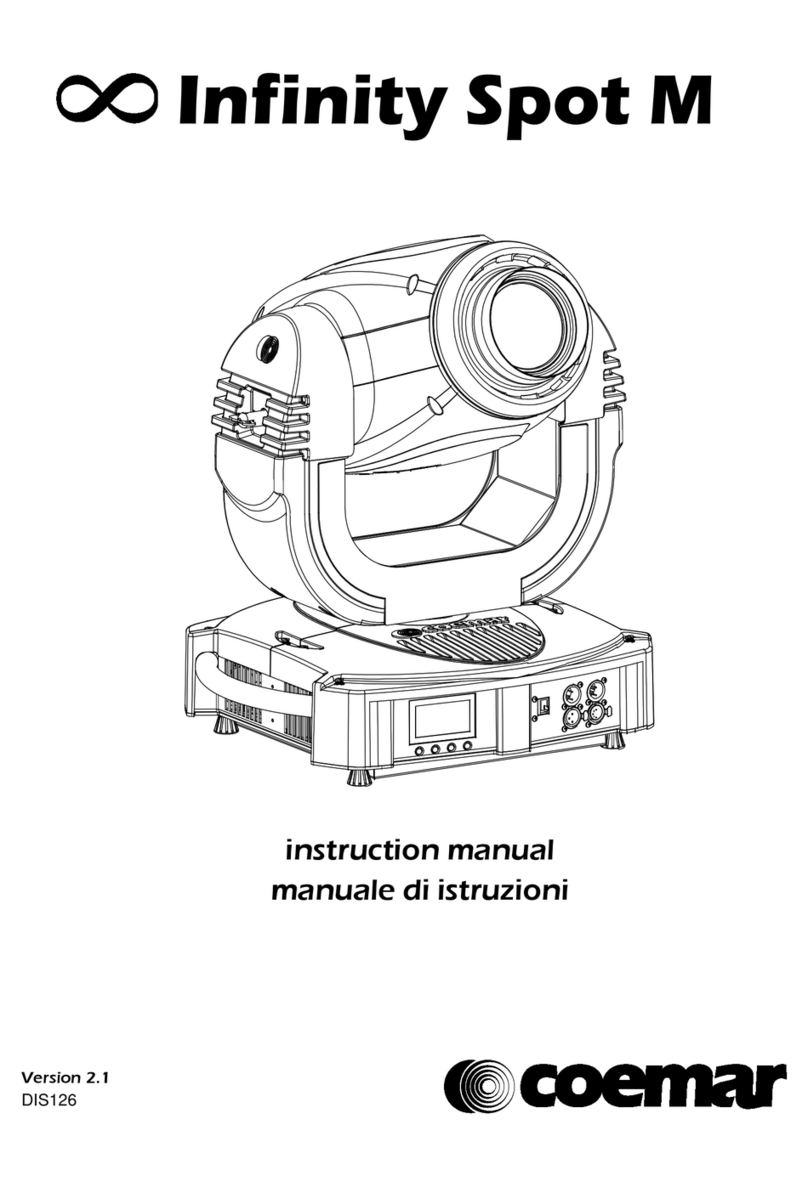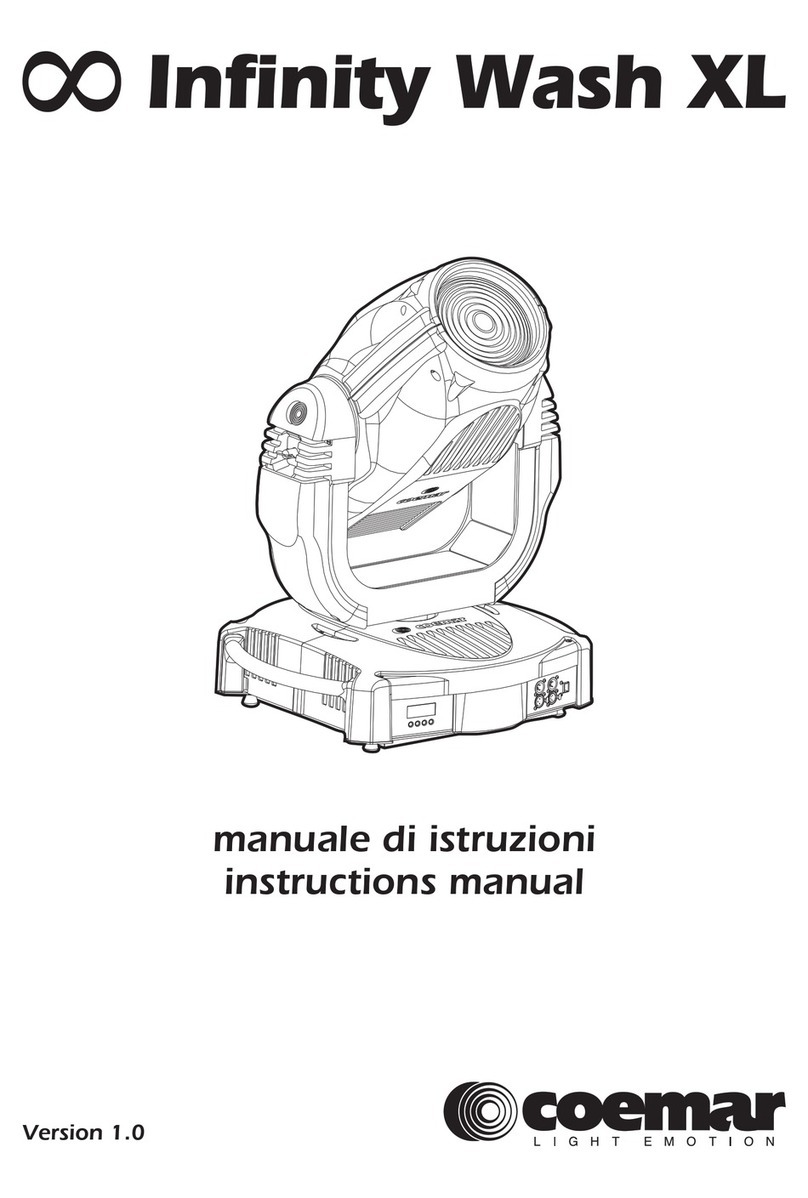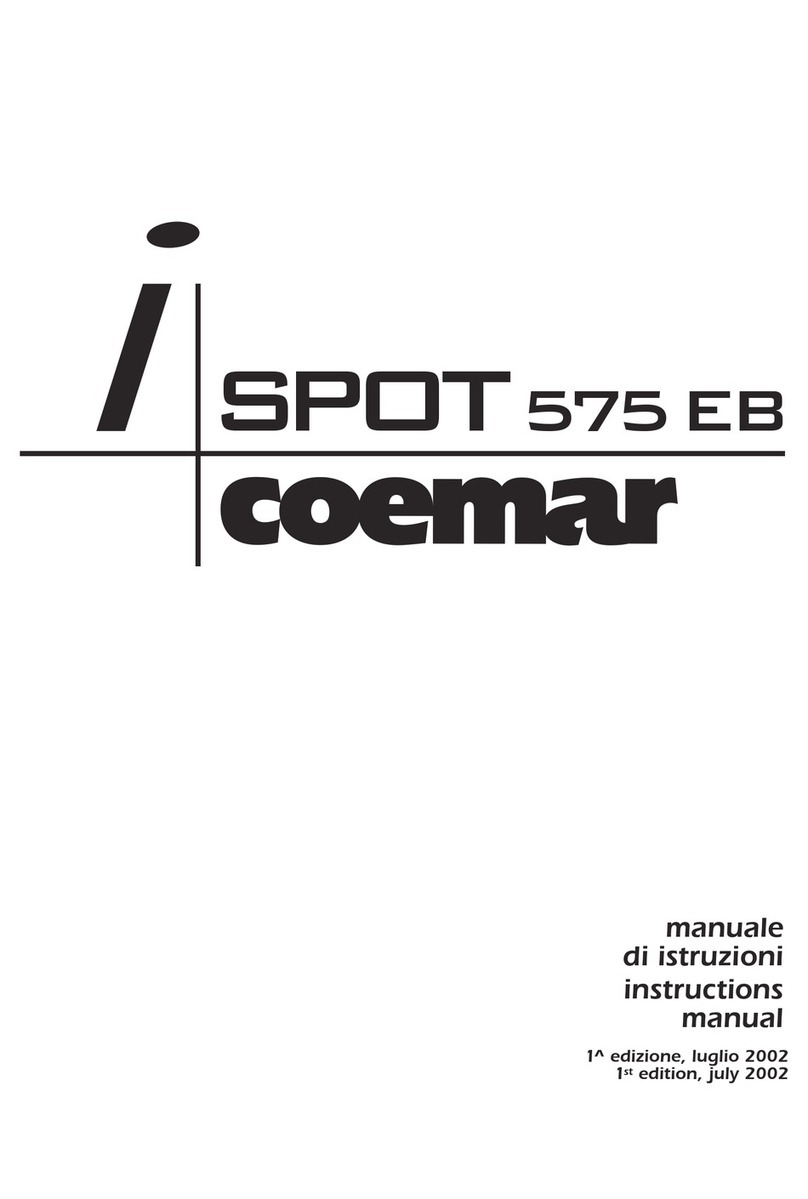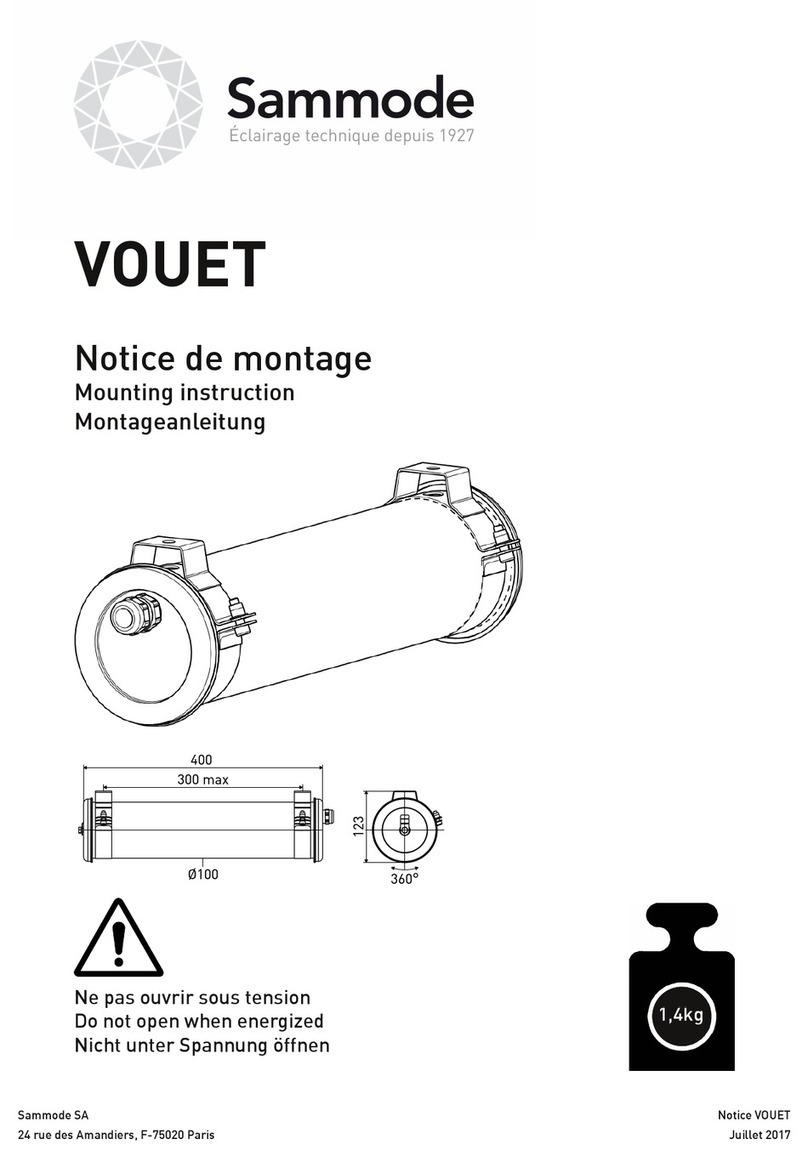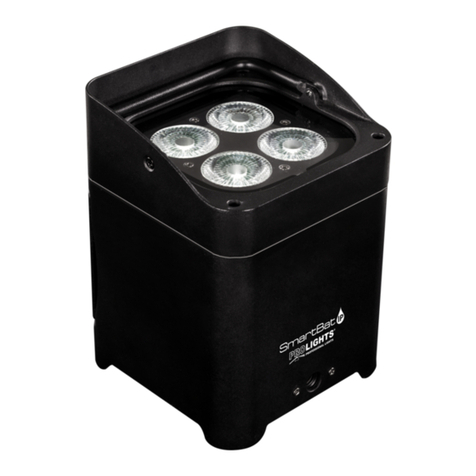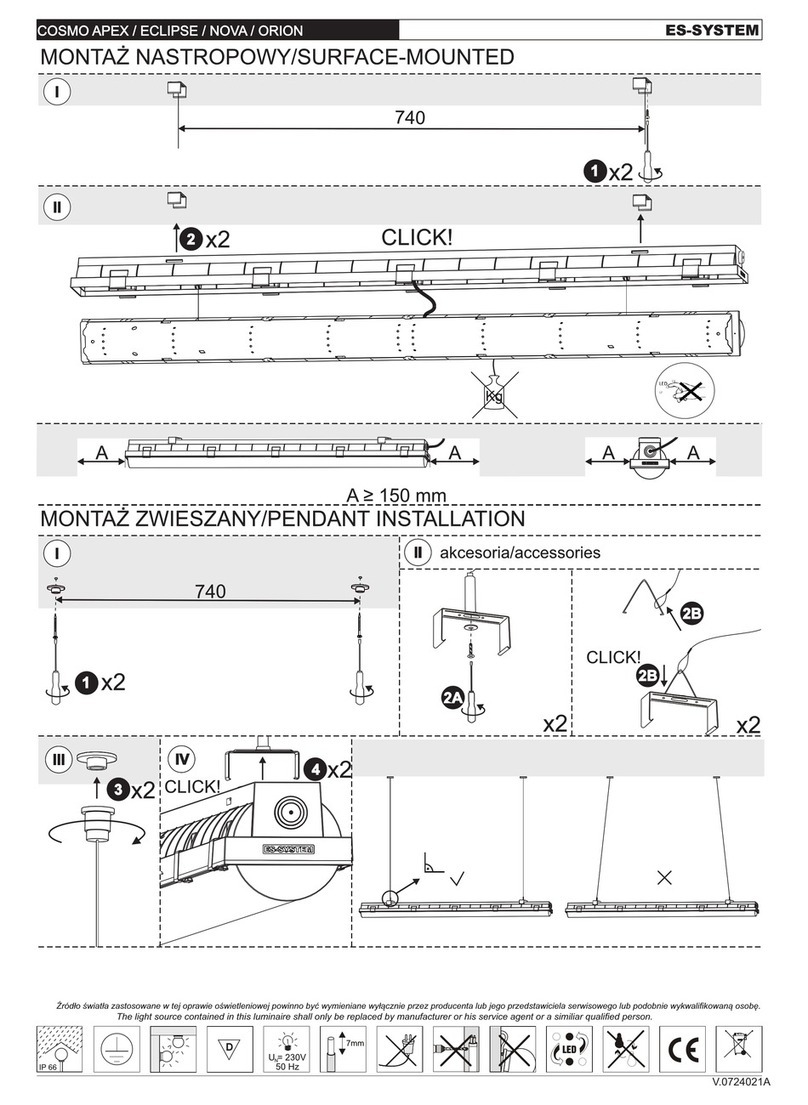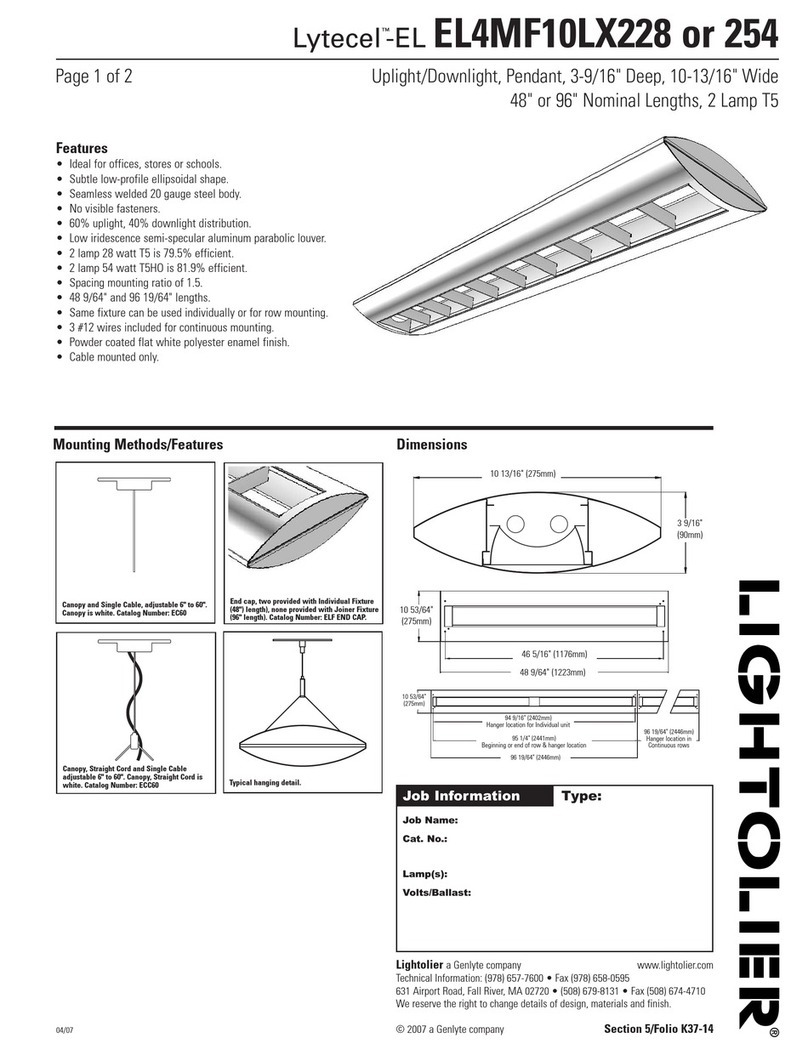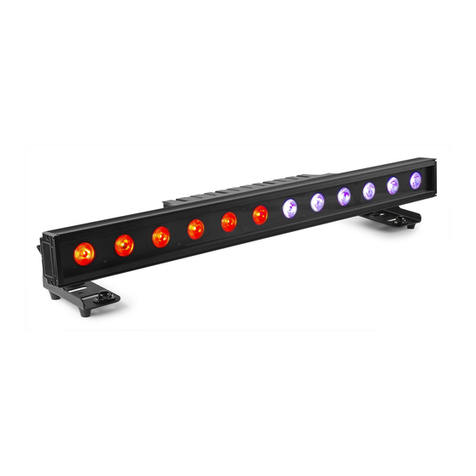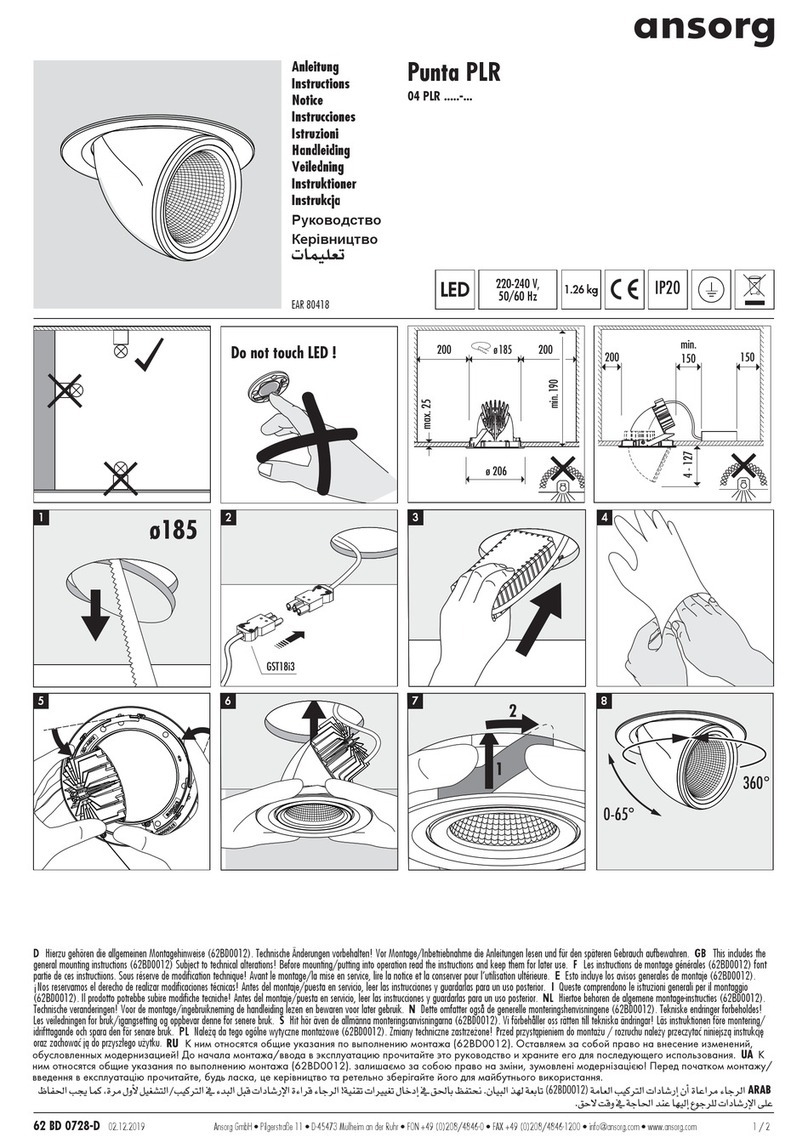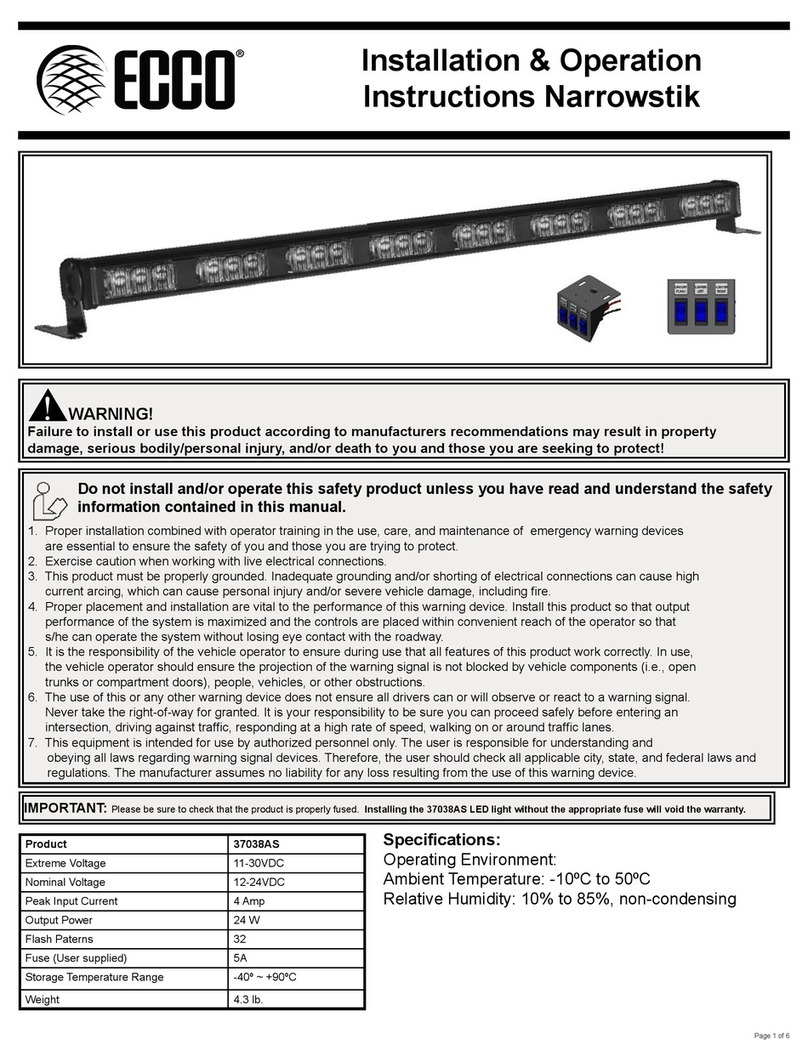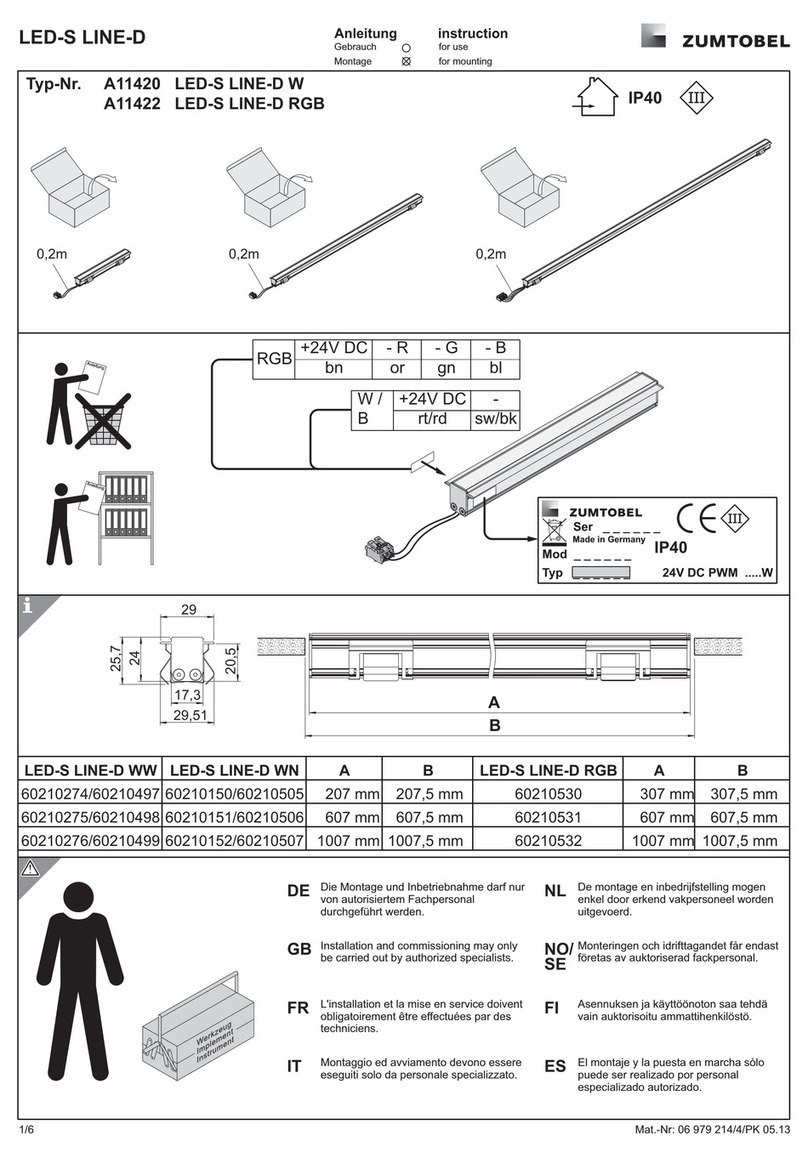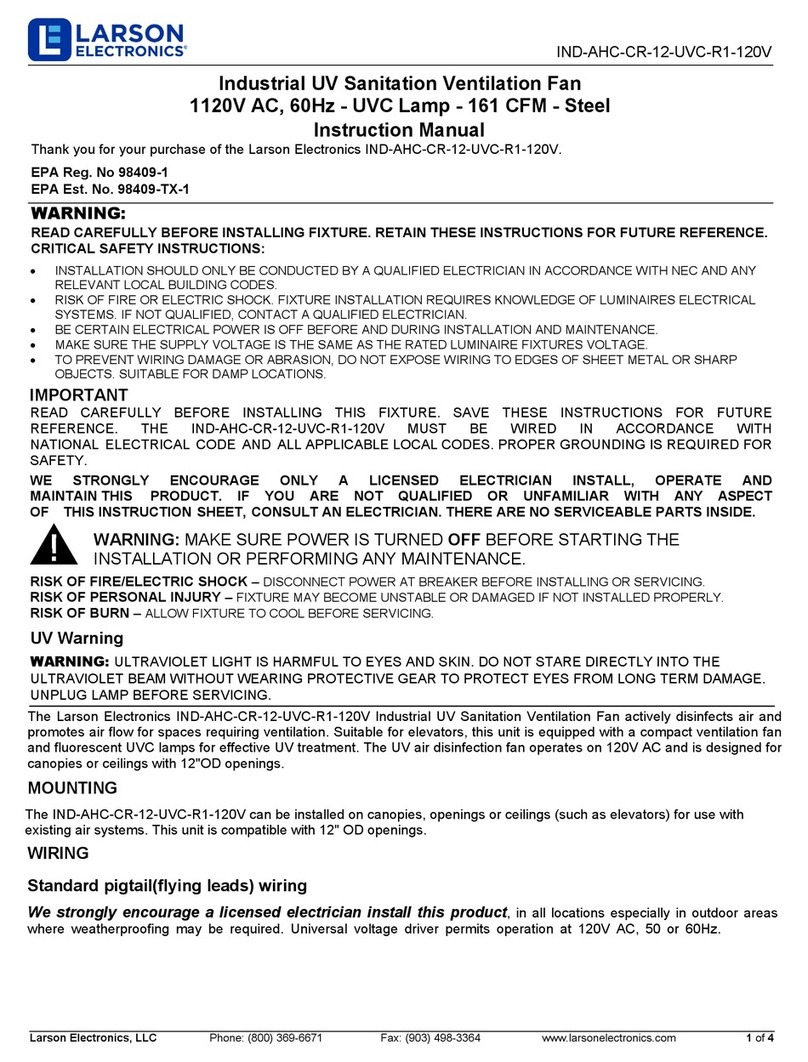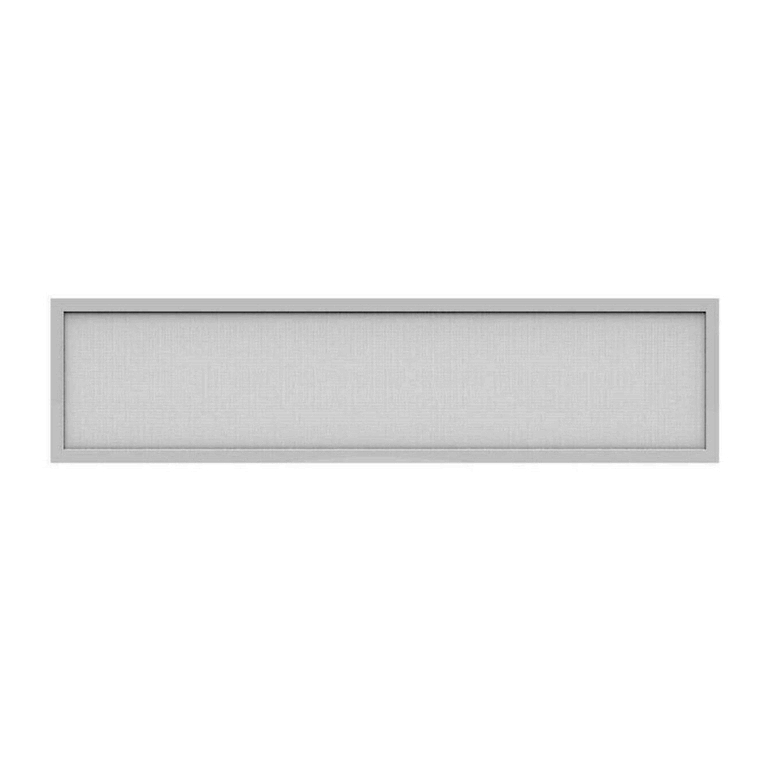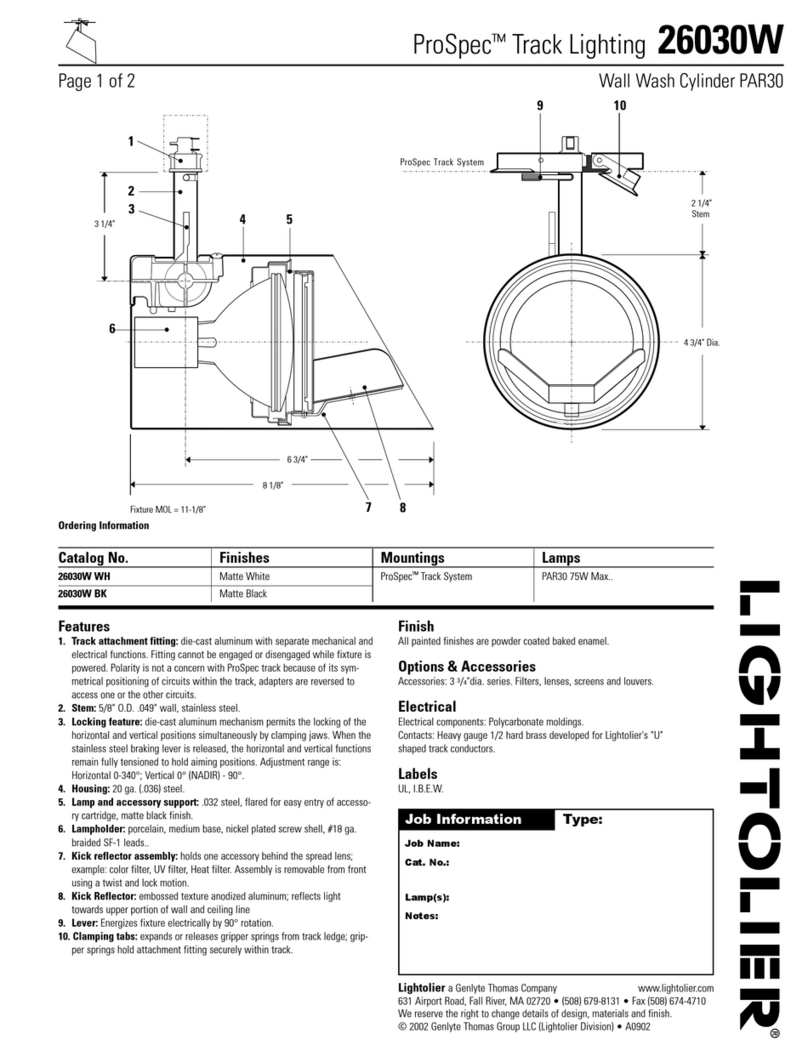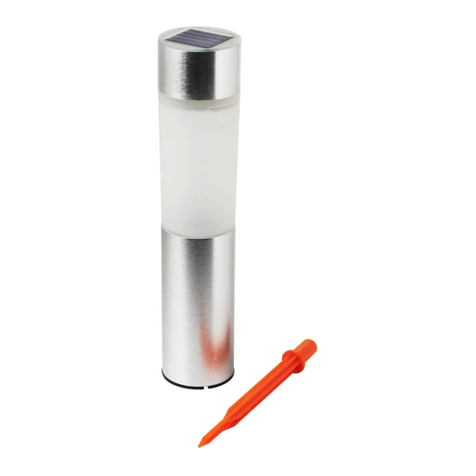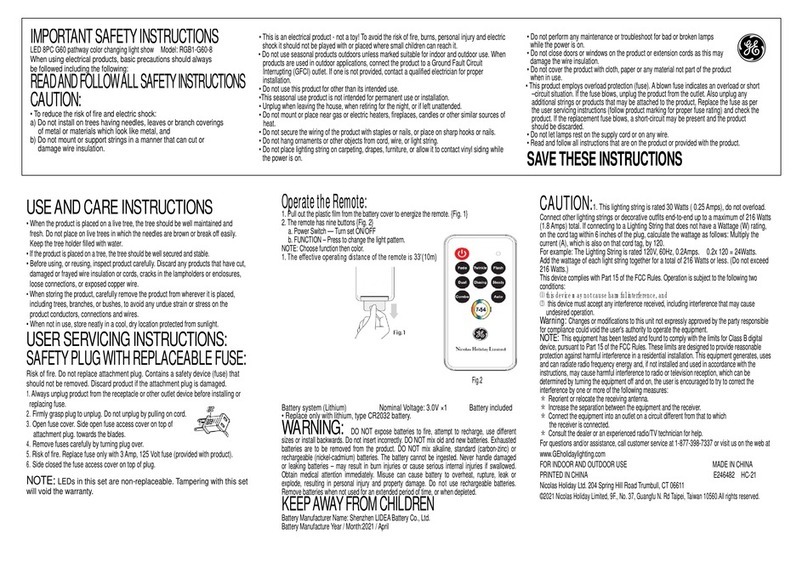Coemar wash halo User manual

manuale di istruzioni
instructions manual
Version 1.0

iWASH halo
numero di serie/serial number
data di acquisto/date of purchase
fornitore/retailer
indirizzo/address
cap/città/suburb
provincia/capital city
stato/state
tel./fax/
Prendete nota, nello spazio apposito, dei dati relativi al modello e al rivenditore del vostro iWash Halo: ci per-
metteranno di assistervi con la massima rapidità e precisione.
Please note in the space provided above the relative service information of the model and the retailer from
whom you purchased your
iWash Halo
: This information will assist us in answering any technical enquiries
with the utmost speed and accuracy.
ATTENZIONE
:
la sicurezza dell’apparecchio è garantita solo con l’uso appropriato delle presenti istruzioni, per-
tanto è necessario conservarle.
WARNING
: t
he security of the fixture is granted only if these instructions are strictly followed; therefore it is
absolutely necessary to keep this manual.
Users Manual Version 1.0
edition November 2005

Index
1. Packaging and transportation Pag. 4
1.1. Packaging “4
1.2. Transportation “4
2. General information Pag. 4
2.1. Important safety information “4
2.2. Warranty conditions “5
2.3. CE norms “5
3. Product specifications Pag. 5
3.1. Technical characteristics “5
3.2. Dimensions “5
3.3. Projector components “5
4. Installation Pag. 6
4.1. Mechanical installation “6
4.2. Safety connections “6
5. Powering up Pag. 7
5.1. Operating voltage and frequency “7
5.2. Altering the operating voltage and frequency “7
5.3. Mains connection “8
6. DMX signal connection Pag. 9
7. Turning on the projector Pag. 10
7.1. DMX addressing “10
7.2. DMX functions “11
8. Display panel functions Pag. 12
8.1. Quick guide to menu navigation “12
8.2. Measure and test (MEAS) “13
8.3. Function settings (FUNC) “14
8.4. Rapid scrolling “14
8.5. Connecting the DR1 “14
8.6. Use of RJ45 connector “15
8.7. Turning on the projector with no articulated movement “15
8.8. Resetting counters “15
9. Lamp installation and alignment Pag. 16
9.1. Lamp installation “16
9.2. Aligning the lamp in the optical path “17
10. Opening up the projector Pag. 19
11. Thermal protection Pag. 19
12. Maintenance Pag. 19
12.1. Periodic cleaning “19
12.2. Periodic maintenance “19
12.3. Fuse replacement “19
12.4. Electronic motor alignment “20
13. Spare parts Pag. 20
14. Error messages Pag. 21
15. Frequently asked questions Pag. 22
3
English

Congratulations on having purchased a Coemar product. You have assured yourself of a fixture of the highest quality, both in compo-
nentry and in the technology used. We renew our invitation to you to complete the service information on the previous page, to expe-
dite any request for service information or spares (in case of problems encountered either during, or subsequent to, installation). This
information will assist in providing prompt and accurate advice from your Coemar service centre.
Following the instructions and procedures outlined in this manual will ensure the maximum efficiency of this product for years to come.
1.1. Packaging
Open the packaging and ensure that no part of the equipment has suffered damage in transit. In case of damage to the equipment,
contact your carrier immediately by telephone or fax, following this with formal notification in writing.
Packing list
Ensure the packaging contains:
1 iWash Halo
1 instruction manual
2 cam-lock support brackets
1.2. Transportation
The iWash Halo should be transported in its original packaging or in an appropriate flight case.
2.1. Important safety information
Fire prevention:
1. iWash Halo utilises a Philips TXO 750W 100V; the use of any alternative lamp is not recommended and will null and void the fix-
ture’s warranty.
2. Never locate the fixture on any flammable surface.
3. Minimum distance from flammable materials: 0,5 m.
4. Minimum distance from the closest illuminable surface: 2 m.
5. Replace any blown or damaged fuses only with those of identical values. Refer to the schematic diagram if there is any doubt.
6. Connect the projector to mains power via a thermal magnetic circuit breaker.
Preventing electric shock:
1. High voltage is present in the internals of the unit. Isolate the projector from mains supply prior to performing any function which
involves touching the internals of the unit, including lamp replacement.
2. For mains connection, adhere strictly to the guidelines outlined in this manual.
3. The level of technology inherent in the iWash Halo requires the use of specialised personnel for all service applications; refer all work
to your authorised Coemar service centre.
4. A good earth connection is essential for proper functioning of the projector.
5. Mains cables should not come into contact with other cables. Never operate the unit without proper earth connection.
6. Do not operate the projector with wet hands or in an area where water present.
7. The fixture should never be located in an exposed position, or in areas of extreme humidity. A steady supply of circulating air is essen-
tial.
Safety:
1. The projector should always be installed with bolts, clamps, and other fixings which are suitably rated to support the weight of the
unit.
2. Always use a secondary safety chain of a suitable rating to sustain the weight of the unit in case of the failure of the primary fixing
point.
3. The external surface of the unit, at various points, may exceed 150°C. Never handle the unit until at least 10 minutes have elapsed
since the lamp was turned off.
4. Always replace the lamp if any physical damage is evident.
5. Never install the fixture in an enclosed area lacking sufficient air flow; the ambient temperature should not exceed 35°C.
6. Wait at least 10 minutes after the unit has been turned off prior to attempting to replace the lamp.
7. The proejctor contains electronic and electrical components which should under no circumstances be exposed to contact with water,
oil or any other liquid. Failure to do so will compromise the proper functioning of the projector.
Articulated movement
The projector has a pan range of 540° in its base and a tilt range 252° in its yoke; do not obstruct the projector whilst it is undertaking
articulated movement.
Forced ventilation
You will note several air vents on the body of the projector. To avoid any problems associated with overheating, never obstruct any of
these vents as this may seriously compromise the proper operation of the unit.
Protection rating against penetration by external agents:
1. The fixture is classified ordinary apparatus ; its protection grade against penetration by external agents,solid or liquid, is IP 20
2. General information
1. Packaging and transportation
English
4

2.2. Warranty conditions
1. The fixture is guaranteed for a period of 12 months from the date of purchase against manufacturing or materials defects.
2. The warranty does not extend to damage caused by inappropriate usage or use by inexperienced operators.
3. The warranty is immediately void if the projector has been operated or dismantled by unauthorised personnel.
4. The warranty does not extend to fixture replacement.
5. The serial number of the projector is required for any advice or service fro your authorised Coemar service centre.
2.3. CE norms
The projector meets or exceeds all applicable CE requirements.
3.1. Technical characteristics
Power: 115/208/230/240 Vac 50/60Hz
Nominal current: 3.9A @ 230V
7.1A @ 115V
Power factor: cos ϕ= 0,98
Lamp wattage: 750W TH
Maximum ambient temperature: 35°C / 95°F
Weight: 25.1 Kg / 55.33 Lbs
IP rating: IP20
3.2. Dimensions
3.3. Components
Component description
A. Front body housing
B. Zoom effect group
C. Color wheel group
D. Colors changer group
E. Reflector group
F. Lampholder group
G. Rear body housing
H. Body rotation group
J. Yoke
K. Rear base housing
L. Front base housing
M. Base
A
B
C
H
D
E
F
G
H
J
M
L
K
445mm
17,52”
425mm
16,73”
450mm
17,72”
670mm
26,38”
590mm
23,23”
495mm
19,49”
170mm
6,7”
225mm
8,86”
3. Product specifications
5
English

4.1. Mechanical installation
iWash Halo may be either floor or ceiling mounted. For floor mounting, the unit is provided with four rubber mounting feet.
For ceiling mounted installations, Coemar includes two cam-lock (A) support brackets.
The two cam-lock brackets may be mounted in two different positions (B& C) on the base of the iWash Halo. The cam-lock brackets
are affixed via a 1/4 nut. Please ensure that they are correctly seated and firmly tightened into position.
For ceiling mounted installations we suggest the use of appropriate clamps or fixings to attach the fixture to the mounting surface. Clamps
may be attached to the central hole provided in the cam-lock brackets, as shown in the following diagram.
The structure from which the unit is hung should be of sufficient rating to hold the weight of the unit, as should any clamps used to hang
the unit. The structure should also be sufficiently rigid so as not to move or shake whilst the projector moves during its operation.
Do not install the projector in locations where it is readily accessible by aunthorised or untrained personnel.
4.2. Safety connections
If the iWash Halo is affixed to a structure the use of a safety chain designed to meet relevant safety standards is recommended. You may
attach the safety chain to the holes “D” located on the base of the fixture and to the structure itself.
If using an after-market safety chain not manufactured by Coemar, ensure that it is of sufficient rating to hold the weight of the unit.
D
ATTENTION!!
Ensure that the structure from which the unit is hung is of sufficient rating to hold the weight of the unit,
as are any clamps, nuts and bolts used to hang the unit.
B
C
345mm
13,58”
A
293mm
11,54”
4. Installation
6
English

5.1. Operating voltage and frequency
The projector may operate at voltages of 115, 208, 230 or 240VAC at a frequency of 50 or 60Hz. Coemar presets (barring specific
requests) a voltage of 230v at a frequency of 50Hz.. The preset voltage is indicated on the base of the projector.
5.2. Altering the operating voltage and frequency (Reserved for technical personnel only)
If the factory preset operating voltage and frequency do not correspond to those in use in your country of operation, you may alter the
settings as described in the following paragraphs.
1. Loosen the screws on the cover of the base of the unit, as shown in the
diagram below, using an appropriate screwdriver, thereby removing the
cover completely and allowing access to the internal components of the
base of the iWash Halo.
2. Locate the transformer in the base of the unit.
3. Select a voltage from amongst 115, 208, 230 or 240V by disconnecting
cable n° 5 and moving it to the correct voltage. Refer to the sticker locat-
ed on the transformer to ensure the proper terminal is selected for your
requriements.
Cable number 10 must not have its position altered under any cir-
cumstances!
4. If the voltage setting is 115V replace the fuses located on the rear pamnel
of the base. The fuse T2A, suitable for 208/230/240 V, must be replaced
with a fuse T3A, and the two fuses must be replaced by two fuses T15A.
The fuses are in a plastic envelope together with this instruction manual.
5. When you have made changes, note these on the outside of the iWash Halo.
6. Replace and fasten all the housings as per their original positions.
ATTENTION!!
Incorrect selection of operating voltage and frequency will seriously compromise the
functioning of the projector and will immediately void the warranty.
factory set
main at:
100V
115V
208V
230V
240V
50Hz
60Hz
5. Powering up
7
English

5.3. Mains connection
Mains cable characteristics
The mains cable provided is thermally resistant, complying to the most recent international standards. It meets or exceeds VDE and IEC norms, IEC
331,IEC 332 3C,CEI 20 35.
NB: In case of cable replacement, similar cable with comparable thermal resistant qualities must be used exclusively (cable 3x1.5 ø external
10 mm, rated 300/500V, tested to 2KV, operating temperature -40° +180°, Coemar cod. CV5309).
Connecting to mains power
For connection purposes, ensure your plug is of a suitable rating to sustain the maximum current:
•115V 10 amps constant current in normal operation
•208/230/240V 4.5 amps constant current in normal operation
Locate the mains cable which exits the base of the unit and connect as shown below:
ATTENTION!!
• The use of a thermal magnetic circuit breaker is recommended for each projector. Strict adherance to all regulatory
norms is higly recommended.
• iWash Halo should never be supplied mains power via a Dimmer; this is potentially dangerous.
• Prior to powering up the projector, ensure that the model in your possession correctly mathces the mains supply avai-
lable to you.
• A good earth connection is essential for the correct operation of the iWash Halo. Never connect the projector to main
power if the green/yellow earth cable is not correctly connected
• All cable and plug connections should be carried out by fully qualified and licenced personnel only.
ground
neutral
live
brown
blue
yellow/green
main
8
English

Control signal is digital and is transmitted via two pair screened ø0.5mm cable as per international standards for the transmission of
DMX512 data. Connection is serial, utilising XLR3 and XLR5, male and female sockets located on the base of the iWash Halo, labeled
DMX 512 IN and OUT (see diagram).
Plug/socket connections for XLR3 and XLR5 connectors:
Pin connections conform to the international standard as per the following table:
pin 1 = GND
pin 2 = data -
pin 3 = data +
If using a controller which output signal via an XLR 5 (5 pin) socket, do not use pins 4 and 5, leave them unconnected.
ATTENTION!!
Ensure that all data conductors are isolated from one another and the metal housing of the connector.
Pin number 1 should never be connected to the device’s power supply.
3
2
1
Controller
Standard
DMX 512
OUT
out
in
Ad altri iWash Halo
Connect to other iWash Halo
out
in
6. DMX signal connection
9
English

After having followed the preceding steps, turn on the projector via the main Power switch.
The display and will show in sequence the software version installed in the 2 onboard microprocessors:
the display “D”and the master “M”.
For example, upon turning on power, the iWash Halo may show:
D1.30 (display pcb “D” software version)
M1.02 (master pcb “M” software version)
The projector will perform a reset function on all the internal and external motors. This will last some few seconds, after which it will be
subject to the external signal from the controller. The display will remain fixed on indicating correct DMX 512 signal reception.
If the display flashed, there is no DMX signal being received. Check your cabling and your controller.
7.1. DMX addressing
Each projector utilises 16 channels of DMX 512 for complete control (for further information, see section 7.2. DMX functions).
DMX addresses
To ensure that each projector accesses the correct signal, it is necessary to correctly address each fixture. Any number between 1 and
497 can be generated via the multifunction panel of the unit. This procedure must be carried out on every projector being used. When
powered up initially, each projector will show A001 which indicates DMX address 001; a projector thus addressed will respond to com-
mands on channel 1to 16 from your DMX controller. A second unit should be addresses as A017, a third as A033 and so on until
the final projector has been addressed.
Altering DMX addresses
1. Press the +or -buttons until the display shows the required DMX address. The characters in the display will flash to indicate that the
selection is not yet stored in memory.
2. Press the enter button to confirm your selection. The display panel will cease to flash and the projector will now respond to the new
DMX 512 address.
Important Note: holding down the +or -buttons will cause the display to alter at an increased speed, allowing a faster selection to be made.
ATTENTION!!
If you alter the DMX with no DMX controller connected, the characters in the display panel will continue to flash
even after you have pressed the ENTER button.
m
e
n
u
m
e
n
u
e
n
t
e
r
e
n
t
e
r
+
+
AOO1
7. Turning on the projector
10
English

7.2. DMX functions
channel function type of control effect
1Xaxis,basemovement
(pan) proportional
controlofthepanmovementofthebeamoflightvia
proportionalrotationofthebasemotor
0-255 0% - 100%
2
Xaxis,finebasemovement
(pan)
proportional
finecontrolofthepanmovementofthebeamoflightvia
proportionalrotationofthebasemotor
0-255 0% - 100%
3Yaxis,yokemovement
(tilt) proportional
controlofthetiltmovementof thebeamoflight via
proportionalrotationoftheyokemotor
0-255 0% - 100%
4Yaxis,fineyokemovement
(tilt) proportional
finecontrol ofthetiltmovement ofthebeamof lightvia
proportionalrotationoftheyokemotor
0-255 0% - 100%
step standard(fast)
0-10 0%-4%
step
ultrafastmovement
(idealforpositioningduringprogramming)
11 - 25 4%-10%
proportional vector mode (from fast to slow)
26 - 127 10% - 50%
proportional trackingmode (from fastto slow)
128 - 247 50% - 97%
step tracking mode (slow)
248 - 255 97% - 100%
step shutterclosed 0 - 9 0% - 4%
proportional variable speedstrobingeffect,fromslowtofast 10 - 66 4% - 26%
step shutteropen 67 - 68 26% - 27%
proportional
sequencedpulseeffect,slowclosing,fastopening
(variablespeedpulsing,from slow to fast)
69 - 125 27% - 49%
step shutteropen 126 - 127 49% - 50%
proportional
sequencedpulseeffect,fastclosing,slowopening
(variablespeedpulsing,from fast to slow)
128 - 184 50% - 72%
step shutteropen 185 - 187 73% - 73%
proportional randomstrobe effectwithvariablespeedfromslowtofast 188 - 244 74% - 96%
step shutteropen 245 - 255 96% - 100%
step spot 0-9 0%-4%
proportional fromnarrowbeam (Spot) to wide beam(Flood) 10 255 4% - 100%
step noeffect
090%-4%
proportional ovalbeam(pareffect)rotatablethrough0°to180° 10 230 4% - 90%
step 9°spotlens
231 255 91% - 100%
step no colour,whitebeam 0 - 7 0% - 3%
colour1 8 - 27 3% - 11%
colour2 28 - 47 11% - 18%
colour3 48 - 67 19% - 26%
colour4 68 - 87 27% - 34%
colour5 88 - 107 35% - 42%
colour6 108 - 127 42% - 50%
proportional
rainboweffectinacounterclockwisedirection
from fast to slow
128 - 190 50% - 75%
step norotation 191 - 192 75% - 75%
proportional rainboweffectinaclockwisedirectionfrom slow to fast 193 - 255 76% - 100%
step white,nocolour
0-9 0%-4%
proportional proportionalcontrolofthecyancolour,fromwhite
tofullcyan 10 - 255 4% - 100%
step white,nocolour
0-9 0%-4%
proportional
proportionalcontrolofthemagentacolour,fromwhite
tofullmagenta
10 - 255 4% - 100%
step white,nocolour
0-9 0%-4%
proportional
proportionalcontroloftheyellowcolour,from white
to full yellow
10 - 255 4% - 100%
step white,nocolour
0-9 0%-4%
proportional
proportionalcontrolof thecolourtemperature(CTB) from0
to100%
10 - 255 4% - 100%
coloursarecentredintheopticalpath 0 - 125 0% - 49%
colourarepositionedproportionatelyintheopticalpath 126 - 255 49% - 100%
park,noeffect 0 - 29 0% - 11%
panandtiltreset(onlyonce) 30 - 65 12% - 25%
resetall motorsexceptstrobo,pan andtilt(onlyonce) 66 - 100 26% - 39%
resetallmotors except strobo(onlyonce) 101 - 135 40% - 53%
resetall motors (only once) 136 - 170 53% - 67%
black-outofthebeamlightduringPAN/TILTmovementand
colourchanging
171 - 249 67% - 98%
park,noeffect 250 - 255 98% - 100%
-
100%
0
255
-
0%
stepor
proportional
control
selectablevia
channel15
step
proportional
adjustoutputintensityfrom0to100%
10
colourwheel
11
cyan
5
7
dimmer
6
12
magenta
decimal
percentage
movementspeed
shutter, strobe
PAR effect filter and
9° spot lens
9
8
zoom
Note1:alltheresetfunctionsaredelayedby6secondstopreventaccidental activation
13
yellow
15
CTB
14
16
motorsreset
+
activateblack-out
synchronised with PAN/TILT
movementand
colour changing
step
colour positioning mode
(colourselectionviachannel10)
11
English

The display panel of the iWash Halo shows all the functions available; it is possible to change some of those parameters and to add
some functions.
Changing the preset settings made by Coemar can vary the functions of the device so that it may not respond to a DMX 512 controller
being used to control it. Carefully follow the instructions before applying any variations or selections.
NOTE: the symbol ☞shows which key has to be pushed to obtain the desired function .
8.1. Quick guide to menu navigation
For your convenience, the following is a guide to navigating the menu system of the projector.
F U NC
☞
enter
MEAS
☞
enter
PDIR
☞
+o–
TDIR
☞
+o–
OPTO
☞
+o–
FANS
☞
+o–
DISP
☞
+o–
LED
☞
+o–
RESE
☞
+o–
OFSE
☞
+o–
DEMO
☞
+o–
X.Y
☞
+o–
PAN
☞
+o–
ID
☞
+o–
TEMP
☞
+o–
VOLT
☞
+o–
DMIN
☞
+o–
RATE
☞
+o–
ALRM
☞
+o–
HOUR
☞
+o–
AOO1
☞
menu
TEST
☞
+o–
Press together enter and menu keys
for 10 seconds: the display will show
alignement functions menu
A023
new DMX address
☞
+o–A023 DMX address ☞
enter
☞
+o–
8. Display panel functions
12
English

8.2. Measure and test (MEAS)
The internal microprocessor of the iWash Halo allows for several diagnostic and output parameters to be
displayed. You may record, in this menu, determine the position in which the projector will come to rest when turned on with no dmx
signal attached.
☞
menu
AOO1
MEAS
☞
enter
VOLT main voltage
To measure the DC main voltage in volt.
You must consider normal the values between
26V and 36 V.
13.8V
v oltage measurement
☞
enter
CH01
from channel
CH16
to channel
10
DMX value
255
DMX value
☞
enter
☞
+o–
DMIN DMX value on each channel
reading of DMX value (0/255), received by each
of the 16 channels on DMX 512 line.
☞
enter ☞
enter
RATE DMX rate
reading of DMX 512 signal value. ☞
enter 22
value reading
NDMX
no dmx signal
NO.AL
no alarm message
ALRM alarm
Reading of Warning message
sequences (errors) shown during reset
operation
☞
enter
☞
+o–O PER
alarm message
58C
temperature measurement
TEMP temperature
to measure the internal temperature in °C☞
enter
☞
+o–
☞
+o–
☞
+o–
☞
+o–
☞
+o–
☞
+o–
TEST test
function test
☞
+o–
10
value reading
☞
+o–
☞
enter
☞
enter
☞
enter
☞
+o–
HOUR working time
working time (in hours)
589
value reading
1230
value reading
LIFE
lamp life after last reset
LIFS
life of all lamps
used on the unit
UNIT
projector life
☞
enter
N.B.: reset the LIFE value when
changing the lamp
☞
+o–0128
☞
+o–0050
☞
+o–0010
☞
+o–0020
☞
enter
☞
+o–0000
☞
+o–☞
enter 0128
☞
enter 0128
☞
enter
☞
enter
☞
enter
☞
enter
☞
enter
☞
+o–
☞
+o–
☞
+o–
☞
+o–
☞
+o–
☞
+o–
☞
enter PAN
pan movement ☞
enter
es. 0127
☞
enter
es. 0127
☞
enter
es. 0127
☞
enter
es. 0127
☞
enter
es. 0127
☞
enter
es. 0127
☞
enter
es. 0127
SURE
☞
enter ☞
enter
☞
+o–0140
☞
enter
☞
+o–☞
enter
es. 0127
☞
+o–0180
☞
enter
☞
+o–☞
enter
es. 0127
☞
+o–
☞
+o–
☞
+o–0000
☞
enter ☞
enter
es. 0127
☞
+o–
☞
+o–0110
☞
enter ☞
enter
es. 0127
TILT
tilt movement
DIMM
dimmer activation
SHUT
shutter activation
EFF
effect activation
Z OOM
zoom activation
COLR
color wheel selection
CYAN
cyan activation
MAGE
magenta activation
Y E L L
yellow activation
CTB
ctb activation
STOR
to record the position of the unit and of its internal
components. If DMX signal is not applied, the recorded
setting will appear at the end of reset operation when
the unit is switched on.
☞
+o–
☞
+o–
☞
+o–
☞
+o–
☞
+o–
☞
+o–
☞
+o–
☞
+o–
☞
+o–
☞
+o–
☞
+o–
13
English

8.3. Function settings (FUNC)
The projector allows the altering of several functions and for selecting personalised settings.
8.4. Rapid scrolling
Via the iWash Halo display it is possible to rapidly scroll through the various numbers displayed in the menu in the following manner:
1. Pressing the +or -buttons will cause the number to scroll more quickly.
2. Pressing and holding the +button and then the -button will cause the numbers to jump to the highest value.
3. Pressing and holding the -button and then the +button will cause the numbers to jump to the lowest value.
8.5.Connecting the DR1
All the functions available via the display menu are also available via the DR1 (cod. 9703).
The DR1 is a remote device designed for technical users who need to perform tasks on the projectors whilst they may be located in inac-
cessible positions. It acts as a remote control.
For example, the DR1 eliminates the need for climbing up truss structures to gain direct physical access to the projector to alter such
parameters as DMX address, reading outputs such as lamp life as well as all other functions available via the digital display unit on the
projector.
In order to utilise the DR1 remote device, you must first activate the identifying number of the projector ID, which must be unique in
the particular DMX universe in which it is currently installed.
ATTENTION!!
• If you set a projectors identification number to “0” it will not be able to communicate with the DR1.
• Never assign the same ID to two or more projectors. This may jeapordise the functioning of the entire system.
(The DR1 will show an error message).
PDIR pan movement inversion
To reverse horizontal movement direction of the beam
on DMX level variation.
TDIR tilt an movement inversion
To reverse vertical movement direction of the beam on
DMX level variation.
OPTO optic sensor de-activation
To deactivate the optic sensor function with return in
position of the unit if accidentally knocked out of the
place.
FANS fans control
Fan status control through PCB (Strd) or fans always on
(On).
DISP reverse display
To reverse the display reading depending on mounting
position (base or suspended).
LEDdisplay control
To disable display visualisation.
RESE reset
Reset function
DEMO demo program
To see all the unit function
☞
menu
AOO1
FUNC
-– -– -– -–
reset activation
CW
Clockwise
CCW
Counter-clockwise
CW
Clockwise
CCW
Counter-clockwise
ON
sensor activation
OFF
sensor deactivation
☞
+o–
☞
+o–
☞
enter
☞
enter
☞
enter
☞
enter
☞
+o–
☞
+o–
☞
enter
☞
enter
☞
+o–
☞
+o–
STRD
fans speed control
ON
fans always on ☞
enter
☞
enter
☞
+o–
☞
+o–
AA
base downwards
reversed, base upwards ☞
enter
☞
enter
☞
+o–
☞
+o–
AA
☞
enter
☞
enter
☞
enter
☞
enter
☞
enter
☞
enter
DFSEdefault function setting
To set all the functions at the original values,
but for the alignement operations.
SURE
flashing
☞
enter
PAN P an movement control
Pan mode: reduction of rotation angle from 540°to
400°
5 4 0
pan 540°
400
pan 400°☞
enter
☞
enter
☞
+o–
☞
+o–
☞
enter
O N
Pan Tilt activation
OFF
Pan Tilt deactivation ☞
enter
☞
enter
☞
+o–
☞
+o–
☞
enter
ON
display actived
AUTO
display switch off after 6 second ☞
enter
☞
enter
☞
+o–
☞
+o–
☞
enter
☞
enter
☞
enter
ID ID number setting
To set the unit’s ID number from 1 to 250
1--250
numeric value
☞
+o–
☞
enter
☞
+o–
☞
+o–X.YPan and Tilt setting
Function without pan/tilt movement
☞
+o–
☞
+o–
☞
+o–
☞
+o–
☞
+o–
☞
+o–
☞
+o–
☞
+o–
☞
+o–
☞
+o–
☞
enter
DEMO
flashing
demo program activation
☞
enter
☞
enter
14
English

The method for setting an identification number ID is shown below.
For further information, consult the DR1 instruction manual.
8.6. Use of RJ45 connector
On rear panel of iWash Halo base you find a RJ45 connector , as shown in oicture, that can
be used either for display supply and for software upgrade function.
It’s possible to supply the display through an external battery, and access to menu functions,
without connectinf the unit to the mains.
RJ45 connector can also be used for the connection of DR1+, the remote control that allows to
supply the display, to upgrade the software and to access to all the functions that are usually
selectable from the DR1.
For more information pls. Read the manual of the different devices.
8.6. Turning on the projector with no articulated movement
This function may be useful should you need to power up the iWash Halo whilst it is in its flight case or to re-address it or alter any
parameters and you wish to in the absence of any articulated movement.
1. Turn on the projector whilst holding down the enter, menu and – buttons
The The projector will proceed with a reset of all its motors with the exception of those which control articulated movement, the pan
and tilt motors, which remain static.
2. You may alter the DMX address or any other parameter without any articulated movement occuring
3. To return to normal functioning of the iWash Halo simply turn the projector off and on via the Power switch or activate the Reset
function.
8.7. Resetting the counter
The lamp life counter needs to be reset to zero at every lamp change to provide accurate information on lamp life.
When turning on the iWash Halo , simultaneously hold down the +and – buttons. The projector will restart with its counter reset.
The projector has reset the LIFE counter.
To verify that this operation has occured:
1. Press the menu button and then press enter.
2. Press the +or -buttons until MEAS is displayed, then press enter.
3. Press the +or -buttons until HOUR (hours) is displayed, then press enter.
4. Press the +or -buttons until LIFE (lamp life) is displayed, then press enter.
5. If the display shows 0000, the counter has been reset.
N.B. You may also wish to verify that other electronic counters such as LIFS (total lamp operating lives) and UNIT (total proejctor ope-
rating life) have remained unaltered.
m
e
n
u
m
e
n
u
e
n
t
e
r
e
n
t
e
r
+
+
m
e
n
u
m
e
n
u
e
n
t
e
r
e
n
t
e
r
+
+
☞
menu
AOO1
FUNC
ID ID number setting
To set the unit’s ID number from 0(no ID, to 250).
1--250
numeric value
☞
+o–
☞
enter
☞
+o–
☞
enter
☞
enter
15
English

iWash Halo uses (Tungsten eXtreme Output) halogen lamp, high quality, compact and incredibly performing: a result of the
co-operation between Coemar and Philips.
The lamp is available at Coemar; its characteristics are listed in the following chart.
The fixture’s internal temperature can reach 250° C after 5 minutes, with a maximum peak of 350° C; ensure that the lamp is cold prior
to attempting removal. The fixture should be allowed to stand and cool for 10 minutes prior to its removal.
Lamps must be handled with great care.
9.1. Lamp installation
1. Use a suitable tool to loosen the two screws “A“ which affix the lampholder assembly at the rear of the projector.
2. Remove the lampholder assembly “B”. 3. Identify the lampholder “C“.
ATTENTION!!
Disconnet the unit from mains power prior to attempting lamp installation or replacement
Make sure the projector is sufficiently cooled.
Lamp Philips TXO 750W 100V
Coemar code 105115
Power 750W
Luminous flux 18600 lm
Colour temperature 3200° K
Base GX 9,5
Approximate lamp life 300 hours
9. Lamp installation and alignment
16
English

4. Insert the lamp
The lamp used is manufactured from quartz glass and should be handled with care; always adhere to the instructions supplied in the
lamp’s packaging. Never touch the glass directly, use the tissue provided in the lamp’s packaging. The GX 9,5 lampbase is symmetrical in
construction. DO NOT USE UNDUE FORCE. In case of difficulty, re-read the instructions and repeat the procedure.
5. Replace the lampholder assembly in its original position and refasten the two screws “A” which were previously removed.
9.2. Aligning the lamp in the optical path
Aligning the lamp in the optical system is achieved via the 3 adjusters at the rear of the projector. This procedure should be undertaken
to maximise output, properly align the lamp in the optical system and to avoid the possible overheating of the internal components due
to the incorrect focusing of the beam onto components not intended to be exposed to this.
Alignment procedure
Alignment is effected by the 3 adjusters A, Band Clocated on the lampholder assembly. The lamp should be on, black-out fully open,
and no colours selected. If the lamp is not correctly aligned, a hot-spot will be readily noticeable. Using the 3 adjusters in unison, you
will need to bring the hot-spot to the centre of the beam (adjusters Band C) and then flatten the beam to maximum uniformity (adju-
ster A).
Vertical adjustment
Adjuster “C“ acts on a lever and spring assembly to position the lamp via a vertical movement within the reflector; rotate it until correct
positioning is achieved.
Horizontal adjustment
Adjsuter “B“ acts on a lever and spring assembly to position the lamp via a horizontal movement within the reflector; rotate it until cor-
rect positioning is achieved.
Axial adjustment
Adjuster “A“ moves the entire lamp assembly axially within the unit; rotate it until correct positioning is achieved, resulting in a flat, even
beam.
A
B
C
Adjust lamp position
by turning screws
A, Band C
lamp
lamp
Caution hot lamp
Isolate electrically
before re-lamping
L
O
O
S
E
N
T
O
R
E
-
L
A
M
P
L
O
O
S
E
N
T
O
R
E
-
L
A
M
P
ATTENTION!!
Each time you change the lamp, we recommend the following be carried out:
• realign the lamp in the optical path to avoid overheating dichroics.
• reset the lamp life counter (as described in section 8.7. Resetting the counter).
17
English

By removing the casing, complete access is available to the internals of the projector.
1. Use a screwdriver to remove the screws which affix the front and rear housings.
2. Lift the housing to gain access to the internals of the fixture.
ATTENTION!!
Disconnet the unit from mains power prior to attempting lamp installation or replacement
Make sure the projector is sufficiently cooled.
10. Opening up the projector
18
English

A thermal sensor in the body of the iWash Halo protects the unit against overheating.
The thermal sensor operates by removing voltage to the lamp if the ambient temperature rises above a preset maximum due to either
less than ideal air circulation around the fixture or in the event of cooling fan failure.
Whilst every possible precaution has been taken to ensure the trouble-free operation of your iWash Halo, the following periodic main-
tenance is highly recommended.
To gain access to the internals of the unit refer to chapter 10. Opening up the projector of this manual.
12.1. Periodic cleaning
Lenses and reflectors
Even a fine layer of dust can reduce the luminous output substantially. Regularly clean all lenses and the reflector using a soft cotton
cloth, dampened with a specialist lens cleaning solution.
Fans and air passages
The fans and air passages must be cleaned approximately every 6 weeks; the period for this periodic cleaning will depend, of course,
upon the conditions in which the projector is operating. Suitable instruments for performing this type of maintenance are a brush and
a common vacuum cleaner or an air compressor.
12.2. Periodic maintenance
Lamp
Check the lamp and replacing it if there is any observable damage or deformation due to heat.
Mechanicals
Periodically check all mechanical devices for wear and tear; gears, guides, belts, etc., replacing them if necessary. Periodically check the
lubrication of all components, particularly the parts subject to high temperatures. If necessary, lubricate with suitable lubricant, available
from your Coemar distributor.
Electrical components
Check all electrical components for correct earthing and proper attachment of all connectors, refastening if necessary.
12.3. Fuse replacement
Locate the fuse, which protects the lamp and electronics, in the base of the iWash Halo.
Using a multimeter, test the condition of the fuse, replacing it with one of equivalent type if necessary.
ATTENTION!!
Always remove mains power and ensure the unit is sufficiently cooled prior to opening up the housing.
12. Maintenance
11 Thermal protection
19
English

12.4. Electronic motor alignment
The display panel of the iWash Halo allows for the electronic alignment of the projector’s motors in the optical system. This procedure
is performed by Coemar at the factory. It may be useful to perform this procedure in the case of internal components being replaced.
Altering the factory settings may radically alter the functioning of the projector. Carefully read all of the following prior to attempting any
changes.
Electronic calibration
1. Press the menu button and then enter to confirm.
2. Press the +or -button until FUNC is displayed. Then press enter.
3. Press the +or -button until RESE is displayed.
4. Press the enter and menu buttons simultaneously, holding them for at least 10". The motors will perform a reset and the display will show
-- -- -- -- for a few seconds. After this, the display will show PAN confirming that you have entered electronic calibration mode.
Note: Simultaneously pressing the +and -buttons will return the calibration value to 128 (default).
All the components of the iWash Halo are available as replacement spares from your authorisded Coemar service centre. Accurate
description of the fixture, model number, and type will assist us in providing for your requirements in an efficient and effective manner.
13. Spare parts
RESE
AOO1
☞
+o--
FUNC
☞
+o--
☞
menu
PAN pan alignment
Pan movement alignment
TILT tilt alignment
Tilt movement alignment
SH UT shutter alignment
Shutter movement alignment
D I M M dimmer alignment
Dimmer level alignment
EFF effect wheel alignment
Effect alignment
COLR colour wheel alignment
colour wheel alignment
CYANcyan
Cyan filter alignment
MAGEmagenta
Magenta filter alignment
YELL yellow
Yellow filter alignment
ZOOM zoom
Zoom lens alignment
CTB CTB
CTB filter alignment
LAMP lamp power level
Lamp power level setting
END end
To end the electronic setting procedure and
confirm therecording.
☞
enter 0128 ☞
enter
☞
+o–es. 0120
☞
+o–
☞
+o–☞
enter 0000 ☞
enter
☞
+o–es. 0140
☞
enter 0128 ☞
enter
☞
+o–es. 0130
☞
+o–
☞
enter 0128 ☞
enter
☞
+o–es. 0125
☞
+o–
☞
enter 0128 ☞
enter
☞
+o–es. 0135
☞
+o–
☞
enter 0128 ☞
enter
☞
+o–es. 0132
☞
+o–
☞
+o–
☞
enter 0128 ☞
enter
☞
+o–es. 0121
☞
+o–
☞
enter 0128 ☞
enter
☞
+o–es. 0120
☞
+o–
☞
enter 0128 ☞
enter
☞
+o–es. 0120
☞
+o–
☞
enter
☞
+o–es. 0127
0128
☞
enter A001
☞
+o–
☞
enter
☞
enter LEV.0 ☞
enter
☞
+o–es. LEV.3
☞
+o–
☞
enter 0128 ☞
enter
☞
+o–es. 0121
☞
+o–
Press together enter and menu keys
for 10 seconds: the display will show
alignement functions menu
ATTENTION!!
The alignment procedure can only be carried out when DMX 512 signal is connected.
ATTENTION!!
This procedure should only be undertaken by qualified and experienced technical personnel..
20
English
This manual suits for next models
1
Table of contents
Other Coemar Light Fixture manuals

